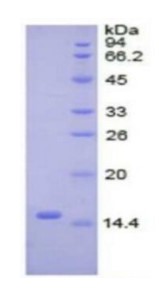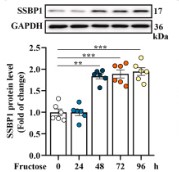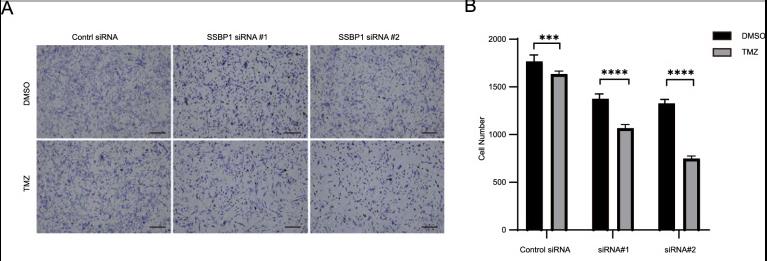SSBP1
-
Official Full Name
single-stranded DNA binding protein 1
-
Overview
SSBP1 is a housekeeping gene involved in mitochondrial biogenesis (Tiranti et al., 1995 (PubMed 7789991)). It is also a;subunit of a single-stranded DNA (ssDNA)-binding complex involved in the maintenance of genome stability (Huang et;al., 2009) (PubMed 19683501). -
Synonyms
SSBP1; single-stranded DNA binding protein 1; single stranded DNA binding protein; single-stranded DNA-binding protein, mitochondrial; SSBP; PWP1-interacting protein 17; mtSSB; Mt-SSB; SOSS-B1;
- Recombinant Proteins
- Cell & Tissue Lysates
- Protein Pre-coupled Magnetic Beads
- Chicken
- Human
- Mouse
- Rat
- Rhesus Macaque
- Zebrafish
- E.coli
- HEK293
- HEK293T
- In Vitro Cell Free System
- Mammalian Cell
- Wheat Germ
- GST
- His
- His (Fc)
- Avi
- Myc
- DDK
- N/A
| Species | Cat.# | Product name | Source (Host) | Tag | Protein Length | Price |
|---|---|---|---|---|---|---|
| Human | SSBP1-2965H | Recombinant Human SSBP1, GST-tagged | E.coli | GST | 1-148aa | |
| Human | SSBP1-29275TH | Recombinant Human SSBP1 | Wheat Germ | N/A | 148 amino acids |
|
| Human | SSBP1-7584H | Recombinant Human SSBP1, His-tagged | E.coli | His | 17-148aa |
|
| Human | SSBP1-1465HCL | Recombinant Human SSBP1 293 Cell Lysate | HEK293 | N/A |
|
|
| Human | SSBP1-498HF | Recombinant Full Length Human SSBP1 Protein | In Vitro Cell Free System | 148 amino acids |
|
|
| Mouse | SSBP1-16023M | Recombinant Mouse SSBP1 Protein | Mammalian Cell | His |
|
|
| Mouse | SSBP1-8741M | Recombinant Mouse SSBP1 Protein, His (Fc)-Avi-tagged | HEK293 | His (Fc)-Avi |
|
|
| Mouse | Ssbp1-6140M | Recombinant Mouse Ssbp1 Protein, Myc/DDK-tagged | HEK293T | Myc/DDK |
|
|
| Mouse | SSBP1-8741M-B | Recombinant Mouse SSBP1 Protein Pre-coupled Magnetic Beads | HEK293 |
|
||
| Rat | SSBP1-5752R | Recombinant Rat SSBP1 Protein | Mammalian Cell | His |
|
|
| Rat | SSBP1-5411R | Recombinant Rat SSBP1 Protein, His (Fc)-Avi-tagged | HEK293 | His (Fc)-Avi |
|
|
| Rat | SSBP1-5411R-B | Recombinant Rat SSBP1 Protein Pre-coupled Magnetic Beads | HEK293 |
|
||
| Rhesus Macaque | SSBP1-4482R | Recombinant Rhesus monkey SSBP1 Protein, His-tagged | Mammalian Cell | His |
|
|
| Rhesus Macaque | SSBP1-4298R-B | Recombinant Rhesus Macaque SSBP1 Protein Pre-coupled Magnetic Beads | HEK293 |
|
||
| Rhesus Macaque | SSBP1-4298R | Recombinant Rhesus Macaque SSBP1 Protein, His (Fc)-Avi-tagged | HEK293 | His (Fc)-Avi |
|
|
| Zebrafish | SSBP1-2539Z | Recombinant Zebrafish SSBP1 | Mammalian Cell | His |
|
|
| Chicken | SSBP1-5289C | Recombinant Chicken SSBP1 | Mammalian Cell | His |
|
- Background
- Quality Guarantee
- Case Study
- Involved Pathway
- Protein Function
- Interacting Protein
What is SSBP1 protein?
The SSBP1 protein, otherwise known as single-strand DNA binding protein 1, is an important biomolecule that plays a pivotal role in the quintessential biological process of mitochondrion development and functioning. The protein influences an array of cellular processes, including DNA replication, repair, and recombination, which are essential to human health and development.
The molecular discovery of the SSBP1 protein dates back to the 1980s when researchers first identified it as a crucial element involved in the replication, repair, and recombination of mitochondrial DNA. The SSBP1 gene, encoding for the SSBP1 protein, was later mapped and sequenced, revealing it as a significant focus for research in mitochondrial disorders and cancer studies.
The SSBP1 gene is located on the short (p) arm of human chromosome 7 at position 11.23 (7p11.23), extending over a length of about 13.1 kilobases. The gene comprises six exons resulting in three transcripts, two of which encode the same protein isoform that consists of the SSBP1 protein.
The SSBP1 protein exhibits an asymmetric structure dominated by alpha-helices, which allow it to wrap around and bind to single-stranded DNA. These structural elements, along with its N-terminal, facilitate its role in chain exchange between DNA and RNA.
What are the functions of SSBP1 protein?
As mentioned earlier, the SSBP1 protein is seminal in many cellular processes that involve DNA transactions. It predominantly binds to single-stranded regions of the DNA, stabilizing the structure and preventing DNA degradation or unwanted DNA interactions during the replication process.
In addition, the SSBP1 protein plays an important role in the replication of mitochondrial DNA (mtDNA) alongside POLG, the mitochondrial DNA polymerase. Notably, the protein helps in the initiation of mtDNA replication, topologically isolating the replicated strand from the parental strand.
SSBP1 Protein Related Signal Pathway
The protein acts as an important agent in the signalling pathways associated with cancer, primarily in the DNA damage-response pathway. It elicits its function in the pathway by binding to the single-stranded DNA at the site of lesion and subsequently recruiting other proteins, such as DNA polymerases, repair proteins, and helicases. The pathway is triggered in response to DNA damage and is essential for the maintenance of genome integrity and cellular survival.
SSBP1 Protein Related Diseases
Dysfunction or mutation of the SSBP1 protein could lead to various disease conditions. The most prominent among them is the potential association with cancers. Essentially, the SSBP1 gene has exhibited amplification in SEER-cases of stomach, bladder, lung, and breast cancer. Mutations that lead to a loss of SSBP1 may also result in diminished mitochondrial DNA replication and repair, triggering mitochondria-related disorders.
- Cancer: Deregulated expression linked to replication stress tolerance in various cancers. Implicated in genomic instability and tumor progression.
- Microcephaly: Homozygous mutations cause primary microcephaly characterized by reduced brain size due to defective neural progenitor proliferation.
- Genomic instability syndromes: Associated with disorders like Rothmund-Thomson syndrome and Baller-Gerold syndrome presenting with developmental defects, skeletal abnormalities and cancer predisposition.
- Bloom syndrome: SSBP1 interacts with BLM helicase mutated in this disease. Patients have genome instability, growth delay, sun sensitivity and cancer risk.
- Cancer therapy: Targeting SSBP1-dependent pathways can treat cancers with replicative stress e.g. DNA damaging chemotherapy.
- Immunotherapy: Modulating SSBP1 signaling may improve efficacy of immune checkpoint inhibitors in tumors.
- Tissue engineering: Overexpression assists proliferation and DNA integrity of stem cells for regenerative applications.
- Gene therapy: Gene editing tools help correct pathogenic SSBP1 mutations behind genetic disorders.
Given the significant role that the SSBP1 Protein plays in DNA transactions, its strategic application can contribute to advances in medical biology. For instance, in cancer studies, the amplification of the SSBP1 gene could hold potential as a predictive marker for certain types of cancer.
Moreover, because of its role in mitochondrial DNA replication and repair, the protein could be crucial for the development of therapies for mitochondrial disorders. It can be hypothesized that therapeutic enhancement of SSBP1 function could potentially bolster mitochondrial function, providing an avenue for the treatment of such diseases.
- Cancer therapy: Targeting SSBP1-dependent pathways can treat cancers with replicative stress e.g. DNA damaging chemotherapy.
- Immunotherapy: Modulating SSBP1 signaling may improve efficacy of immune checkpoint inhibitors in tumors.
- Tissue engineering: Overexpression assists proliferation and DNA integrity of stem cells for regenerative applications.
- Gene therapy: Gene editing tools help correct pathogenic SSBP1 mutations behind genetic disorders.
High Purity

Fig1. SDS-PAGE (Cat. No.: SSBP1-7584H)
Case 1: Wu WY, et al. SSBP1 drives high fructose-induced glomerular podocyte ferroptosis via activating DNA-PK/p53 pathway. Redox Biol. 2022 Jun;52:102303. doi: 10.1016/j.redox.2022.102303. Epub 2022 Mar 31. PMID: 35390676; PMCID: PMC8990215.
High fructose consumption is a significant risking factor for glomerular podocyte injury. However, the causes of high fructose-induced glomerular podocyte injury are still unclear. In this study, we reported a novel mechanism by which high fructose induced ferroptosis, a newly form of programmed cell death, in glomerular podocyte injury. The researchers performed quantitative proteomic analysis in glomeruli of high fructose-fed rats to identify key regulating proteins involved in glomerular injury, and found that mitochondrial single-strand DNA-binding protein 1 (SSBP1) was markedly upregulated.

(Wen-Yuan Wu, 2022)
Fig2. Western blot analysis of the protein level of SSBP1 in high fructose-stimulated rat glomeruli and podocytes (n = 6 per group).
Case 2: Su J,et al. Identification of SSBP1 as a ferroptosis-related biomarker of glioblastoma based on a novel mitochondria-related gene risk model and in vitro experiments. J Transl Med. 2022 Sep 30;20(1):440. doi: 10.1186/s12967-022-03657-4. PMID: 36180956; PMCID: PMC9524046.
The Researchers identified 21 prognostic DE-MRGs, of which 12 DE-MRGs were selected to construct a prognostic risk score model for GBM. This model presented excellent performance in predicting the prognosis of patients with GBM and acted as an independent predictive factor. Functional enrichment analysis revealed that the risk score was enriched in the inflammatory response, extracellular matrix, and pro-cancer-related and immune related pathways. Additionally, the risk score was significantly associated with gene mutations and immune cell infiltration in GBM. Single-stranded DNA-binding protein 1 (SSBP1) was considerably upregulated in GBM and associated with poor prognosis. Furthermore, SSBP1 knockdown inhibited GBM cell progression and migration. Mechanistically, SSBP1 knockdown resulted in mitochondrial dysfunction and increased ROS levels, which, in turn, increased temozolomide (TMZ) sensitivity in GBM cells by enhancing ferroptosis.

Fig1. Downregulation of SSBP1 increased TMZ sensitivity and enhanced TMZ induces ferroptosis. A Representive images of U87 cells after SSBP1 knockdown, the cells were incubated with TMZ or DMSO and stained with crystal violet. Scale bar: 200 μm. B Quantification of the U87 cell number in 8 random sights.
SSBP1 involved in several pathways and played different roles in them. We selected most pathways SSBP1 participated on our site, such as DNA replication, Mismatch repair, Homologous recombination, which may be useful for your reference. Also, other proteins which involved in the same pathway with SSBP1 were listed below. Creative BioMart supplied nearly all the proteins listed, you can search them on our site.
| Pathway Name | Pathway Related Protein |
|---|---|
| DNA replication | PCNA;MCM6L;RPA3;RNASEH1;RNASEH2A;MCM3;RFC4;MCM4;RFC3 |
| Mismatch repair | MLH1;MLH3;EXO1;RFC5;SSBP1;MSH3;PMS2;RFC2;POLD1 |
| Homologous recombination | RAD51L3;RPA1;SHFM1;NBN;BLM;POLD1;FUZ;RAD51D;RAD54B |
SSBP1 has several biochemical functions, for example, chromatin binding, poly(A) RNA binding, protein binding. Some of the functions are cooperated with other proteins, some of the functions could acted by SSBP1 itself. We selected most functions SSBP1 had, and list some proteins which have the same functions with SSBP1. You can find most of the proteins on our site.
| Function | Related Protein |
|---|---|
| chromatin binding | MLL1;GLI2;SP140L;HMGB3B;BAP1;SP110;MLH3;NFIA;RNF2 |
| poly(A) RNA binding | RALYL;RPL23A;LGALS1;LLPH;RPL11;GTPBP1;CCDC55;SART1;RPL29 |
| protein binding | FAM176B;TUT1;E2F6;PPP3CB;HCFC1;CCDC108;SVIL;JMY;KAT5 |
| single-stranded DNA binding | TDP1;MCM4;SWSAP1;RAD51C;FUBP1;POLR2G;WBP11;ERCC5;PURA |
SSBP1 has direct interactions with proteins and molecules. Those interactions were detected by several methods such as yeast two hybrid, co-IP, pull-down and so on. We selected proteins and molecules interacted with SSBP1 here. Most of them are supplied by our site. Hope this information will be useful for your research of SSBP1.
rev; Kif1c; Top3a; Cdk1; Cep170; Ercc6l; Haus1; Rmi1; Eurl; ere_dna
- Q&As
- Reviews
Q&As (5)
Ask a questionSSBP1 plays a crucial role in the cellular response to DNA damage by facilitating the repair of single-stranded DNA breaks, thereby maintaining genomic stability.
Researchers are exploring the potential of SSBP1 as a biomarker for cancer detection, as abnormal levels or mutations in this protein may indicate underlying DNA repair issues associated with cancer.
Apart from cancer, SSBP1 dysregulation has been associated with certain neurological disorders and autoimmune diseases, making it a potential target for therapeutic intervention.
Some studies suggest that targeting SSBP1 in cancer cells could be a potential therapeutic strategy, as it may sensitize cancer cells to DNA-damaging treatments.
Some research suggests a potential link between SSBP1 dysfunction and neurodegenerative diseases, indicating a broader impact on various aspects of cellular health.
Customer Reviews (3)
Write a reviewIts use in EM studies allows researchers to gain insights into the structural details of proteins and their complexes at high resolution.
Its versatility and reliability make it a great choice for researchers exploring protein dynamics, function, and interactions.
The manufacturer's support team provides extensive technical assistance, helping researchers navigate any challenges they may face throughout their experiments.
Ask a Question for All SSBP1 Products
Required fields are marked with *
My Review for All SSBP1 Products
Required fields are marked with *


